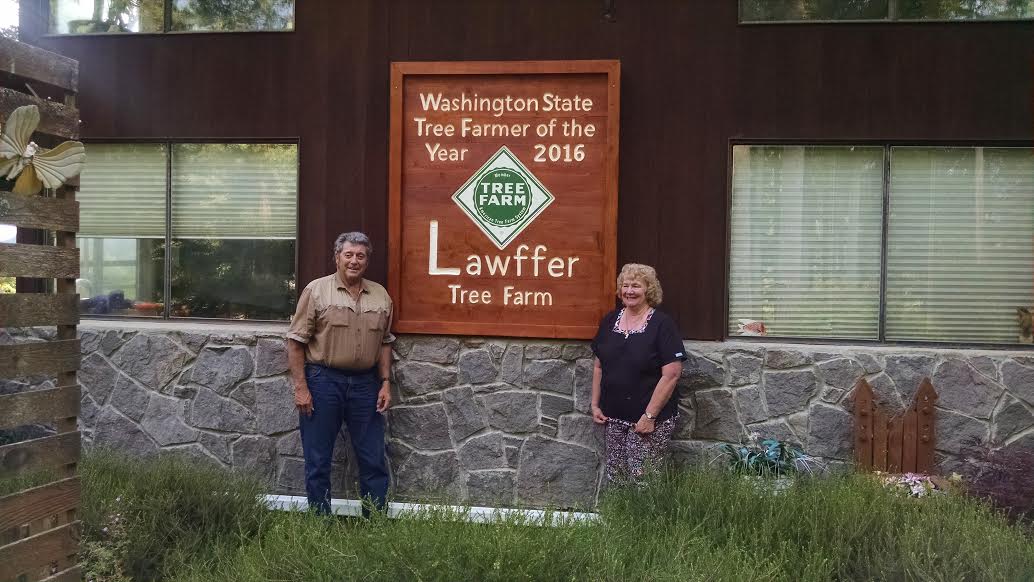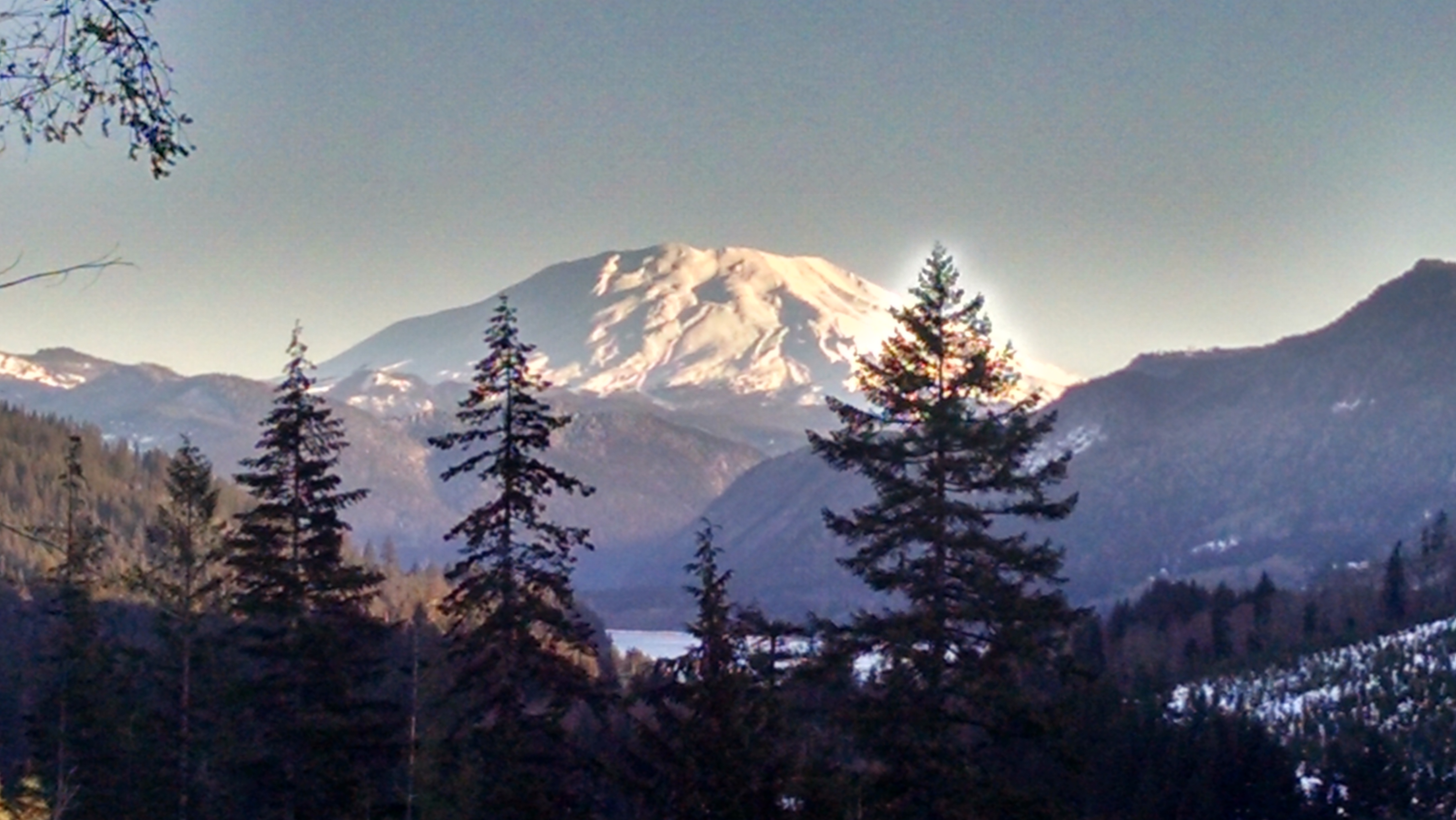Lawffer Family Tree Farm from Washington
 What Makes Them Outstanding?
What Makes Them Outstanding?
Randy and Linda Lawffer inherited the 320-acre Tum Tum Springs Dairy Farm in 1996. Randy Lawffer, born on the farm, remembers the heyday of the family dairy farm and their transition to beef cattle in the mid-1960s. The tired dairy farm is now managed as a tree farm where the third, fourth, and now fifth generation of Lawffer have planted more than 60,000 trees. The fifth generation of Lawffers, seventeen and counting, refer to the property as the Lawffer Family Tree Farm, where trees and beef cattle now grow side by side.
Located at the base of Tum Tum Mountain, just outside the Mt. St. Helens blast zone, the property supports habitat for elk, deer, bear, and bobcat. Canyon Creek cuts across the corner of the property through a deep ravine where locals like to recreate. Over the years, nearby tracts of land have been divided and cleared for residential homes and hobby farms. The Lawffer family has remained close to the land by growing trees, raising cattle, and stewarding nature.
Tree Farmer Story
William Lawffer, Randy’s grandfather, purchased the original fully-stocked tree farm in 1901 and started to clear the land for pasture to start the family dairy. For better or for worse, William got some help clearing the land in 1902 when the Yacolt Burn jumped the Columbia River and roared into the forests of southwest Washington, burning 250,000 acres of forestland across 30 miles in just 36 hours.The forest eventually regenerated and the dairy operation took off. The historic dairy barn on the property, originally built in shortly after 20 was registered as a Washington State Historic Barn in 2015 and is still very much in use as part of the cattle operation. William Lawffer Jr took over the farm in the 1940s and his son, Randy Lawffer, born in 1951, was raised on the farm.
Every Lawffer, old and young, has earned their keep on the farm. Randy recalls working to earn money for his first shotgun around the age of eight by cutting firewood and peeling cascara bark to sell in the city to herbalists. In 1965, Randy helped lay out his first timber harvest to raise the money to buy his first car, a 1966 Pontiac Lemans. Even today, three generations of Lawffers contribute to managing the farm, whether helping with the slaughter of beef cattle or the felling and replanting of trees.Randy took over the cattle operation on the farm in 1976 and the timber operation in 1989, after his father passed. Honoring his father's work, Randy completed a 70-acre harvest project his father had laid out just before he passed. This harvest was the largest harvest ever on the property. It was about that time that the business of growing trees, Randy’s passion, came into focus.
After a couple of years at Clark College, Randy started working as a log scaler at the Columbia River Log Scaling & Grading Bureau, where he met his wife Linda. The couple were married on the farm in 1984. Linda took a job at the local school district as a bus driver to make time for kids and managing the farm.
River Log Scaling & Grading Bureau, where he met his wife Linda. The couple were married on the farm in 1984. Linda took a job at the local school district as a bus driver to make time for kids and managing the farm.
For more than 30 years, Randy and Linda have managed the tree farm all on their own. With a TD9 dozer and a small skidder, the family conducts small-scale harvests (a few acres) every year. As a log scaler, Randy knows how best to lay out the harvest and where to buck the trees. From time to time, they bring in a small portable saw mill and mill boards to maintain outbuildings associated with the farm.
The family has planted more than 60,000 trees on the property and today Randy knows that some of those trees are getting too large for the modern mills. Sometimes they find themselves harvesting a few more tress than they would like, particularly when the export log prices a high.What Randy and Linda enjoy most about managing the family tree farm is the wildlife. In retirement now, the Lawffers try visit all corners of the property each day, whether they are checking up on a planting or taking in the spectacular view of Mt. St. Helens on the rim of Canyon Creek. Every inch of the tree farm is a home for a critter, from the insects to elk. The Lawffers preserve the honey bee trees because they are concerned about the decline of pollinator populations and they’ve shared their pastures for decades with the winter elk population.
Wood
The Lawffer Family Tree Farm specializes in the harvest of larger export logs to pan-pacific  markets. Much of the fir, hemlock, and alder are milled locally. Approximately 10 to 20 loads are harvested each year. Although, this is a sustainable harvest level, Randy often wishes that the market allowed him to keep his trees growing on a longer rotation. Randy sorts and loads the logs onto the hauler with his own equipment. The family does its own replanting and pre-commercial thinning.
markets. Much of the fir, hemlock, and alder are milled locally. Approximately 10 to 20 loads are harvested each year. Although, this is a sustainable harvest level, Randy often wishes that the market allowed him to keep his trees growing on a longer rotation. Randy sorts and loads the logs onto the hauler with his own equipment. The family does its own replanting and pre-commercial thinning.
On occasion, the family harvests logs for poles. The challenge of careful falling and getting the wood out without damaging other trees is difficult but when demand is up, Randy does these selective cuts. Additionally, there are regular inquires for fiddle back and burly maple logs, which can bring an excellent returns. Undersized trees and pre-commercial thin logs often go to the local pulp mill or become firewood for one of the five homes on the farm.
Water
The Pacific Northwest is blessed with an abundance of water. Rainfall at the Lawffer’s farm averages 70 inches per year, where winter and spring have the heaviest rainfall. Natural springs on the property provide clean drinking water for three of the residential homes on the property.
Canyon Creek, which cuts across the northeast corner of the tree farm, empties into Lake Merwin. Steelhead and Bull Trout spawn and migrate through these water bodies. Forest practices on the rim of the canyon require a sensitive approach. Other unnamed creeks on the property are left with buffers required by State Forest Practices rules and harvesting is usually in early fall when considerably less water is present on the property. All roads on the tree farm are well-maintained with gravel to keep mud to a minimum and road shoulders are planted in grass to limit run off.
Wildlife Including Threatened and Endangered Species
One of the greatest benefits of small-scale harvests on the property is the diversity of wildlife. The patches of different age classes offer a mosaic of habitats for different animals. Randy and Linda have learned a lot about the needs of wildlife and are proud to provide a variety of food and shelter for animals on their property.
shelter for animals on their property.
The younger generation of Lawffers hunt on the tree farm and the family selectively harvests deer and elk for sustenance. Browse and rubbing from deer and elk can be hard on replanting areas, but including pockets of pine trees often keep the deer from damaging the higher value firs. Preserving the opportunity to hunt on the tree farm for future generations is an important skill and tradition for the Lawffers.
Migrating birds visit the pastures and wet areas of the tree farm in the spring and fall. Snags have been left for woodpeckers and other cavity nesting birds. Barred owls are common in the area. Eagles are an increasingly more common sight. Humming birds zip across the farm almost year round. All of the charismatic mega fauna occur on or migrate through the tree farm, including elk, bear, bobcat and cougar.
Recreation and Aesthetics Including Special Sites
The Lawffer family, all three generations, do more than just live on the tree farm, the tree farm is their lifestyle. The grandkids love to take ATVs along the roads and trails around the property. They have created several familiar family camping and picnic areas around the tree farm that are used throughout the summer.
One unique business line for the Lawffer Family Tree Farm is their lease to an outdoor adventure company named Bungee Masters. Bungee Master operates a bungee jumping and zip line business on the Lawffer Family Tree Farm. The bridge associated with the bungee jumping operation is owned by the Bungee Masters and spans Canyon Creek. The Lawffers provide access and staging areas for Bungee Masters by way of a lease. The zip line activities were recently added on the tree farm as part of Bungee Masters lease.
With Mt. Saint Helens just nine miles away as the crow files, there are magnificent views from the Lawffer Family Tree Farm above Canyon Creek. The ridge above the canyon is the favorite spot for most of the family. The Lawffer family is proud to share this amazing view with the guests who visit the tree farm to participate in bungee jumping.


